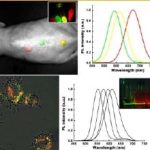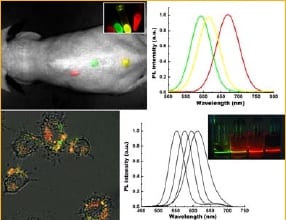Qu antum dots (QDs), semiconductor nanocrystals small enough to exhibit size-dependent properties, have generated tremendous interest due to their unique optical properties. QDs are highly efficient multi-photon absorbers that can be useful for three dimensional multi-photon microscopy and imaging, and their surfaces can be modified to conjugate biomolecules for selective targeting. In a review article, Paras N. Prasad, University at Buffalo, The State University of New York, Buffalo, NY/USA, Ken-Tye Yong, Nanyang Technological University, Singapore, and their co-authors discuss the current state of the art in synthesis of water-dispersible CdTe QDs and their potential applications as probes and sensors for imaging and sensing.
antum dots (QDs), semiconductor nanocrystals small enough to exhibit size-dependent properties, have generated tremendous interest due to their unique optical properties. QDs are highly efficient multi-photon absorbers that can be useful for three dimensional multi-photon microscopy and imaging, and their surfaces can be modified to conjugate biomolecules for selective targeting. In a review article, Paras N. Prasad, University at Buffalo, The State University of New York, Buffalo, NY/USA, Ken-Tye Yong, Nanyang Technological University, Singapore, and their co-authors discuss the current state of the art in synthesis of water-dispersible CdTe QDs and their potential applications as probes and sensors for imaging and sensing.
Most of the QDs used in biological and biomedical applications have been CdSe/ZnS core/shell QDs. Recently, CdTe QDs have received great attention due to their unique tunable optical properties for sensing and electronics applications. However, conventionally synthesized QDs are hydrophobic and incompatible with the aqueous biological environment. For biosensing and bioimaging applications, they must be non-toxic and dispersible in aqueous biological media. The authors describe different techniques used to synthesize and stabilize aqueous phase CdTe QDs. They are convinced that the aqueous phase synthesis technique remains the best approach to making large quantities of high quality CdTe QDs in a single-pot process.
CdTe QDs prepared directly in the aqueous phase can have quantum yield as high as 80% which is much higher compared to CdTe QDs synthesized in organic solvents and later transferred to water. More importantly, the surface of QDs prepared using the aqueous phase technique is terminated with reactive groups that enable them to be directly conjugated with biomolecules for targeted delivery and sensing.
To date, functionalized CdTe QDs were successfully demonstrated for cancer in vitro and in vivo targeting and imaging using various bioconjugated CdTe QD formulations. Currently, targeted delivery of anticancer drug together with QDs in cancerous areas and efficient delivery of drug are under investigation for improving in vivo therapy of cancer.

















